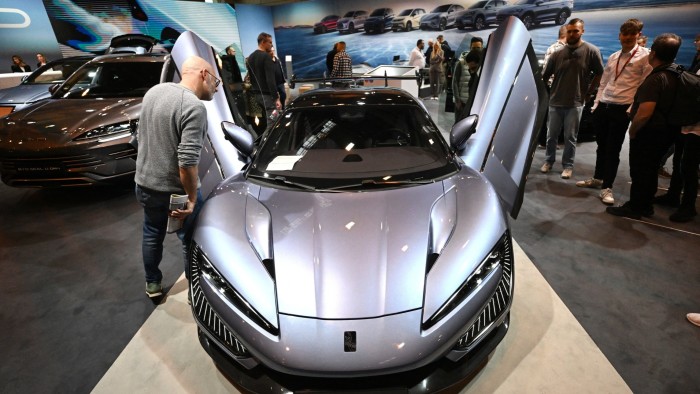Unlock the Editor’s Digest for free
Roula Khalaf, Editor of the FT, selects her favourite stories in this weekly newsletter.
Donald Trump’s latest wave of tariffs seemed like a win for Tesla. Heightened protectionism promised a well-timed shield for the US electric-vehicle maker just as Chinese rivals — especially BYD — were rapidly gaining ground.
But instead of containing the competition, Trump may have handed BYD the very edge it needs to overtake Tesla.
While Elon Musk was sparring in US political circles, halfway across the world in Shenzhen, BYD was quietly tallying up its global EV sales. In the first quarter of this year, it outsold Tesla in pure battery EVs for the second straight quarter, selling more than 416,000 to Tesla’s 336,681.
For years, sceptics dismissed BYD’s rise as circumstantial — a low-cost, China-only brand unlikely to pose a lasting threat. When it first overtook Tesla in 2023, they pointed to plug-in hybrids skewing the numbers. When its growth outpaced the global EV market, it was attributed to home-ground advantage. Even as it expanded abroad, its absence from the US — due to steep tariffs imposed on Chinese-made cars during Trump’s first term — was widely seen as a critical weakness.
That absence, however, has turned into a strategic asset. Because BYD does not sell passenger EVs in the US, it is now insulated from the chaos unleashed by Trump’s latest tariff push. It has no factories, dealerships or market share in the US to defend. And, therefore, no exposure to regulatory uncertainty, retaliatory tariffs or the political turbulence US-exposed automakers must now navigate. Its geopolitical insulation has become a rare luxury in an industry shaped by political crosswinds.
More importantly, years of being shut out of the US forced BYD to redirect its focus to every other major market. That head start in regions less burdened by political barriers, including Europe, Latin America and south-east Asia, has become a defining advantage. In 2024, BYD exported more than 417,000 cars and is on track to double that this year.
Tesla, in contrast, is now exposed on several fronts. As a flagship US brand, it stands directly in the path of potential Chinese retaliation. While its Shanghai gigafactory provides local production capacity, Tesla’s heavy reliance on China — its second-largest market — carries significant risk. Nationalism has long shaped Chinese consumer behaviour, often triggering boycotts that can be swift and damaging. The effects are already showing: sales of Tesla’s China-made EVs fell 11.5 per cent in March, as BYD’s rose by an equal margin.
Europe, once a haven for Tesla, is also shifting. If the EU counters US protectionism with its own tariffs on US-made cars and auto parts, Tesla could be caught in the crossfire. Many of its higher end models are still produced in the US, including the Model X which is assembled with about 60 per cent US content.
Tesla’s sales in Europe have plunged in the first quarter, with countries such as France and Sweden recording declines of more than 40 per cent. Meanwhile BYD sales expanded across the region, with UK deliveries growing more than sevenfold, driven by demand for models such as the Seal, an electric sedan priced at about £46,000.
The numbers point to a broader shift. Tesla’s automotive gross margin fell to 13.6 per cent in the fourth quarter last year — less than half its 2022 peak — while BYD reported a margin of 22.3 per cent. Tesla is still the world’s most recognised EV brand but on core business metrics — sales, margins and growth — BYD has pulled ahead. And perhaps most unsettlingly for Tesla, it is also gaining credibility on the global stage.
That credibility, in part, reflects the contrast between their leaders. Musk is a walking political headline. Wang Chuanfu, BYD’s founder, is a soft-spoken chemist turned engineer. In an era where visibility often invites scrutiny, his restraint has become another of BYD’s strategic advantages.
But all of this goes beyond a rivalry between two companies. It is a telling example of the unintended consequences of Trump-style nationalism. As extreme tariffs become a central pillar of US economic strategy, a clear pattern is emerging: US companies are increasingly caught in regulatory complexity and strategic fallout, while their foreign rivals advance through the gaps created by that very strategy.
Trump’s tariffs were meant to protect American influence. But in trying to bend the world to its own economic logic, the US may be teaching others how to lead without it.


